|
Infiltration: 2000 Journal
University of Chicago Lab School Tunnels (early January 2000): While visiting Liz's hometown of Chicago, she and I decided to tour her old school one day when no one seemed to be using it. We found an unlit staircase heading down from the theatre, and soon enough we were wandering through an abundance of steam tunnels, some larger and some smaller, and various old empty storage rooms and mechanical rooms. We also found an area that looked like a prison for bad students.
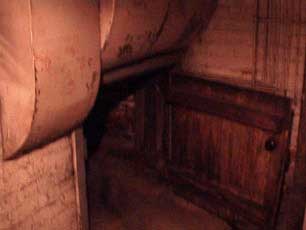 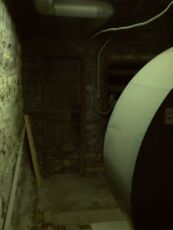
Central Tech Tunnels (February 2000): When we returned to Toronto, we found our lust for utility tunnels sadly unsatiated, and thus decided to investigate the multiple levels of tunnels beneath Central Technical School.
Entering the tunnel system through a tiny door at the back of the school's cafeteria that I'd found on a previous trip, we came into a small unlit room filled with food garbage and presumably many insects and rodents. Passing through this disgusting room as quickly as possible, we lowered ourselves down into the steam tunnels. We followed these to the north end of the school, where the steam tunnels stopped and some ventilation shafts started. These looked promising to me, so I asked Liz to give me 10 minutes to take a look.
 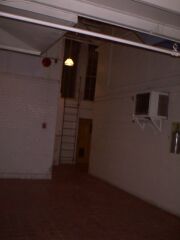
Lowering myself down into the ventilation tunnel, I was thrilled to see a whole other level below me. I climbed down a ladder and investigated the mechanical room below me, which was filled with some distinctly weird gadgetry. I then noticed a map of the level on a wall nearby and realized there were a good dozen rooms down here... and I only had about eight more minutes to explore them all. I scurried around through storage rooms, janitorial rooms and more mechanical rooms like someone on a shopping spree, taking quick, awfully composed pictures as I went, and praying I didn't run into anyone. When I'd met my time limit, I climbed the ladder and returned to the patiently waiting Liz. We then continued to survey the school's very extensive steam tunnel system, eventually letting ourselves out through one of the many alternate exits (all of which are locked from the other side).
Buffalo Central Terminal (early March 2000): Yeah, I know, I'm obsessed. But Liz still hadn't been inside the BCT's great hall, so we picked a freezing miserable weekend in February to have another little Buffalo vacation and another attempt at the Buffalo Central Terminal.
We got there at a nice point in the security cycle (that is, explorers and vandals had had at least a few weeks to find or make ways past various weak barricades), and quickly found a small entrance from the passenger terminal into the partially flooded and icy great hall. Liz was suitably impressed.
We also discovered some sections of the BCT I hadn't seen before: some catwalks and utility tunnels above the great hall, which look down upon it. Definitely a bad place to fall.
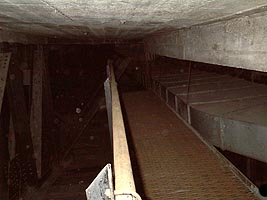 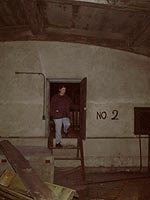
St. Clair Drain (March 2000): A fellow named Mike got in touch with me and invited me to come check out a drain he knew of near Yonge and St. Clair (Toronto) one night. Mike was a very interesting fellow; he was part of some sort of special operations unit in the Canadian army, and he had done a lot of amazing things and been in a lot of amazing places. He struck me as pretty much ready for anything, though unfortunately he hadn't brought a flashlight, which meant we only had my flashlight and glowsticks.
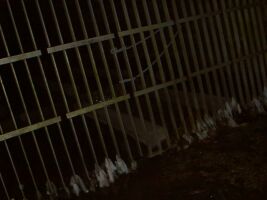 
We pried open the 2-meter-wide grate to the St. Clair drain without much difficulty and proceeded up the pipe. Before long, we crossed under Yonge St. at a very old-looking section of drain made of huge stone slabs. Some portions of the roof and walls had fallen onto the ground. We then came to a stretch where some very unpleasant brown slime was dripping down the walls and forming stalactites on the roof. Mike informed me that at this point we were under the cemetery. After an hour or so of twists, turns and tunnels not taken, we wound up in a horseshoe- or mummy-shaped tunnel, something I'd previously only read about in Il Draino.
 Moving right along, we soon came to a section of the drain that was quite flooded with deep, cold, rapidly-flowing water. Mike told me that this section wasn't usually so flooded, and that he wanted to press on and see if the water level went down enough that we could continue to an interesting exit he knew about. I was feeling pretty sick for some reason. I didn't want to get soaked, but I also really didn't want to go back the (long) way we'd come in, so I accepted Mike's offer to scout ahead and see if we could continue. We agreed that he'd take my flashlight and a glowstick, and that he'd either come back if the route was impassable or give me a signal if I should follow him up the flooded drain.
Moving right along, we soon came to a section of the drain that was quite flooded with deep, cold, rapidly-flowing water. Mike told me that this section wasn't usually so flooded, and that he wanted to press on and see if the water level went down enough that we could continue to an interesting exit he knew about. I was feeling pretty sick for some reason. I didn't want to get soaked, but I also really didn't want to go back the (long) way we'd come in, so I accepted Mike's offer to scout ahead and see if we could continue. We agreed that he'd take my flashlight and a glowstick, and that he'd either come back if the route was impassable or give me a signal if I should follow him up the flooded drain.
So Mike set off while I leaned against the side of the drain and watched the beam of my flashlight slowly move further and further away until I couldn't see it anymore. I stood there feeling cold, wet and sick, and, as time passed, more and more concerned about the fact that I was alone pitch-black tunnel with no idea how to get out. After around 20 to 30 minutes of this, I noticed a green glow coming down the pipe towards me, fast. Soon enough, my glowstick had floated all the way back to me. I eagerly snatched it up and slightly less eagerly plunged ahead into the deep, rushing water. After about 15 minutes, I saw a flashlight beam up ahead, and soon I had joined Mike before the entrance to a very, very small side tunnel.
 I say "side tunnel" but I'm being generous; in actuality, this thing was just a thin pipe, not more than two feet in diameter. A raccoon could walk through it easily enough, but it was clearly not meant to accomodate humans. In fact, if Mike hadn't tossed his backpack ahead of him and begun to wriggle up the pipe, I might have assumed it wasn't humanly possible. I thanked god I hadn't had a lot to eat that day and began to slither up afterwards, thoroughly battering my knees and elbows in the process.
I say "side tunnel" but I'm being generous; in actuality, this thing was just a thin pipe, not more than two feet in diameter. A raccoon could walk through it easily enough, but it was clearly not meant to accomodate humans. In fact, if Mike hadn't tossed his backpack ahead of him and begun to wriggle up the pipe, I might have assumed it wasn't humanly possible. I thanked god I hadn't had a lot to eat that day and began to slither up afterwards, thoroughly battering my knees and elbows in the process.
About ten minutes later we popped out of a manhole in the middle of a parking lot -- cold, exhausted, soaked, scraped, bruised and triumphant.
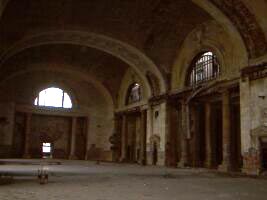 Michigan Central Station (April 2000): While Liz and I were in the Detroit area for a few days, we decided to take a closer look at the building that seems to have inspired more urban exploration websites than any other -- the city's gigantic, long-abandoned train station.
Michigan Central Station (April 2000): While Liz and I were in the Detroit area for a few days, we decided to take a closer look at the building that seems to have inspired more urban exploration websites than any other -- the city's gigantic, long-abandoned train station.
Michigan Central Station is situated in probably the bleakest part of Detroit, off a series of roads where the closed businesses outnumber the open businesses two to one, and where a fair number of the buildings are charred and partially collapsed. The odds of finding a public washroom or payphone in this area are slim, and parking a car on a main street in the middle of the afternoon seems like a dangerous proposition.
Still, the station is ominous and beautiful enough to make the area a minor tourist mecca. Liz and I had very little trouble finding a way under the chain link fence that surrounds most of the station and making our way inside, and once there it was easy to understand why the station has enthralled so many past visitors. The corridors, stairwells and the immense entrance hall are all still quite spectacular; a thorough coating of graffiti acquired over the past several decades has changed the place's personality without diminishing its grandeur. Everything, everywhere seems to be made of high-quality marble, even though much of it is cracked or smashed. Since most of the windows have been broken, there are a hell of a lot of pigeons living in the station. There are a few dead ones, too. Some sick person had hung one of these dead pigeons by a noose in the entrance hall.
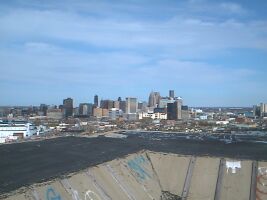 After touring the main floor and looking at the basement a bit, Liz and I headed up. On the second floor, we spotted some sort of authority (either railroad security or a private security guard) peering intently at the building from nearby, so we quickly hid. We knew we'd have to cross his line of vision in order to continue our ascent, so we just waited for him to go away. Fifteen minutes later, however, we were bored, so we just sort of shrugged and figured he could try and come and get us if he wanted to. We kept going. After touring the main floor and looking at the basement a bit, Liz and I headed up. On the second floor, we spotted some sort of authority (either railroad security or a private security guard) peering intently at the building from nearby, so we quickly hid. We knew we'd have to cross his line of vision in order to continue our ascent, so we just waited for him to go away. Fifteen minutes later, however, we were bored, so we just sort of shrugged and figured he could try and come and get us if he wanted to. We kept going.
After examining the less remarkable middle floors of the building (levels 3-19 or so), we came upon the elevator rooms and board rooms at the top of the building, and to the ladder to the roof. On the roof, we surveyed the incredible view of all of Detroit, and Windsor on the other side of the border, then we sunbathed and enjoyed our Cherry Cokes for a while before heading back down. (Liz has much better pictures of this trip at Viewing Hole Gallery.)
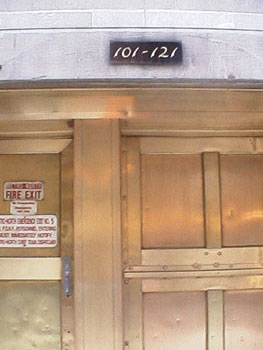 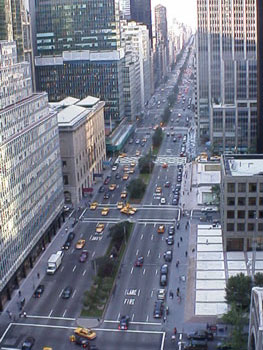
Liz's pictures of the entrance to the staircase to the centre of the earth and the view from the hotel roof.
Waldorf-Astoria Hotel (early July 2000): While visiting New York in July (a very hot and stupid thing to do), Liz and I desperately wanted to find the stairwell under the Waldorf-Astoria hotel that's rumoured to lead seven or eight stories down to abandoned train tunnels. Though we think we found the door we wanted, it was locked and we couldn't find another way down. So we went up.
After touring many of the nice convention and meeting rooms near the top of the hotel, we were looking around a storage closet full of carpet and furniture when we noticed a door at the far end of the closet. Climbing over and around all the stuff, we got to the door, and opened it to reveal a very old, very tempting set of stairs heading up. Liz whipped out her camera as we scurried up into a series of ancient mechanical rooms on different levels, in which we found tiny doors leading out to various rooftops. We never managed to find the way to the uppermost rooftop, but we did get some spectacular views of the city.
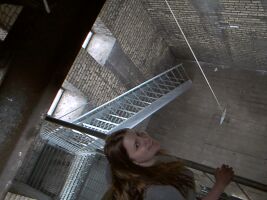 Toronto Churches (July 2000): Ah, Doors Open Toronto, the annual weekend-long festival of urban exploration when interesting Toronto buildings allow the public to come in and take a peek. Sure, there are a few more watchful eyes and velvet ropes than I care for when I'm exploring, but it's usually pretty easy to leave the beaten path a little and plead curiosity if you're caught in the wrong place.
Toronto Churches (July 2000): Ah, Doors Open Toronto, the annual weekend-long festival of urban exploration when interesting Toronto buildings allow the public to come in and take a peek. Sure, there are a few more watchful eyes and velvet ropes than I care for when I'm exploring, but it's usually pretty easy to leave the beaten path a little and plead curiosity if you're caught in the wrong place.
In preparation for an upcoming issue of Infiltration, Liz and I focussed our efforts on churches this year. We managed to find a crypt, though we couldn't get in, and we got inside a few organs and up to a steeple, but I still don't have quite enough material to fill a whole issue on religious buildings. (If you have something to contribute, get in touch!)
University of Toronto tunnels (July 2000): A fellow named Gabe told me he knew about some tunnels under UofT Liz and I hadn't yet visited. We knew about some he hadn't visited, so we agreed to do a little I'll-show-you-mine-if-you-show-me-yours. Liz documented the day's discoveries nicely at Viewing Hole Gallery.
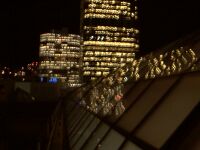 Eaton Centre Roof (August 2000): Usually I prefer to get to the tops of buildings from the inside, but when a stranger named Dan invited me to join him in climbing atop the galleria roof of Toronto’s Eaton Centre, I couldn’t really say no. Crossing the large glass roof, we’d be immensely visible to anyone in the mall below us, and nothing but a thin layer of glass would be keeping us from falling several hundred feet. Yet scaling the famous rooftop and staring down on 12 levels of offices and retail stores sounded like an intensely memorable experience. Besides, Dan assured me that he’d done it once before and it had gone off smoothly.
Eaton Centre Roof (August 2000): Usually I prefer to get to the tops of buildings from the inside, but when a stranger named Dan invited me to join him in climbing atop the galleria roof of Toronto’s Eaton Centre, I couldn’t really say no. Crossing the large glass roof, we’d be immensely visible to anyone in the mall below us, and nothing but a thin layer of glass would be keeping us from falling several hundred feet. Yet scaling the famous rooftop and staring down on 12 levels of offices and retail stores sounded like an intensely memorable experience. Besides, Dan assured me that he’d done it once before and it had gone off smoothly.
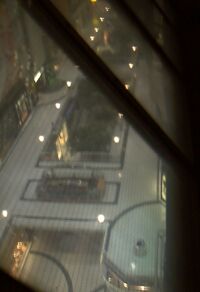 Arriving late one night after the mall had closed, Dan and I made our way up to the top of the building without much trouble. A steel casing for wiring was in place to help most of the way to the top of the arching glass roof, which was good, because we didn’t have any climbing gear aside from some rope we’d found on our way up. Dan went first, scrambling up the ladder quickly and waiting for me at the crest of the roof. I didn’t really like the idea of forcing the roof to support both of us at once, but I didn’t want to yell at Dan to get out of the way, so up I went. The two of us peered down at the empty but well-lit mall in all its majesty, noting happily that the two security guards right below us didn’t seem to be interested in looking up. We then hastily slid down the opposite side of the roof and dismounted, and I let out a huge sigh of relief. This escapade had felt incredibly dangerous to me, especially since I hardly knew Dan, and I hadn’t been quite sure if he was brave or just insane.
Arriving late one night after the mall had closed, Dan and I made our way up to the top of the building without much trouble. A steel casing for wiring was in place to help most of the way to the top of the arching glass roof, which was good, because we didn’t have any climbing gear aside from some rope we’d found on our way up. Dan went first, scrambling up the ladder quickly and waiting for me at the crest of the roof. I didn’t really like the idea of forcing the roof to support both of us at once, but I didn’t want to yell at Dan to get out of the way, so up I went. The two of us peered down at the empty but well-lit mall in all its majesty, noting happily that the two security guards right below us didn’t seem to be interested in looking up. We then hastily slid down the opposite side of the roof and dismounted, and I let out a huge sigh of relief. This escapade had felt incredibly dangerous to me, especially since I hardly knew Dan, and I hadn’t been quite sure if he was brave or just insane.
I didn't find out that Dan was actually insane until a little while later, but that story is told in Infiltration 17.
Rochester Subway (August 2000): Liz and I had occasion to meet a friend in Rochester for the weekend and eagerly went in search of its rumoured abandoned subway system. Here is Liz's account of our quest:
Last weekend, with the aid of a handful of internet printouts and repeated warnings that "I hear a lot of people live down there...", Ninj and I set off in search of the ruins of the Rochester, NY subway system.
Rochester is the smallest city to have built (for reasons that remain somewhat unclear to me) and subsequently abandoned a subway system. Open from 1927-1957, the Rochester Industrial and Rapid Transit Railway operated track for both commuter subway trains and an interurban transit junction underneath downtown Rochester. Ultimately, the subway's inability to serve the outlying suburbs (due to the city's inability to justify the expenditure) led to its failure. The subway was closed, and what remained of the tunnel system was either filled in due to crumbling infrastructure, or left abandoned. (With one exception -- the track area underneath the Gannet newspaper plant near City Hall was still used for paper deliveries up until as recently as 1996.)
Ninj and I elected to enter the portion of the system accessible from South Street, right downtown. After walking around the city extensively the night before, it seemed hard to believe there would be a whole subway system right underneath our feet that no one who didn't care to know such things would ever know about. But, there it was -- behind a fence right behind the Rundell Memorial Library and right before the freeway interchange, a clearly visible portion of the Court Street station revealed itself down a hillside, its siren call unmistakable.
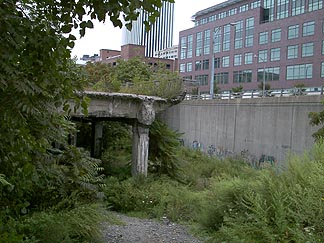 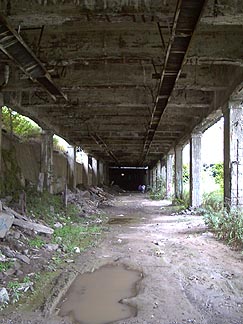
We followed the fence along the hillside a short way until it ended in an explosion of weeds. At the top of this small hill were three well-worn paths down, and a few highway detour signs cast off into the brush by city workers. Before we had even made it halfway down the path, we had company. A scrappy looking 30-ish guy came up from behind us. He was carrying what appeared to be a "to-go" container from a restaurant, and greeted us with a pleasant "Hey! You guys ever been down here before?" to which Ninj rather un-suavely answered "Uh, no, we're from out of town." Takeout-man quickly disappeared somewhere to eat his lunch. Not far behind him were a couple of younger guys wearing really large headphones. They greeted us as well and then disappeared ahead of us to go smoke or drink beer or something.
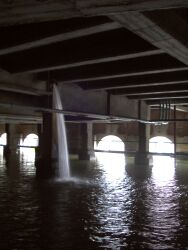 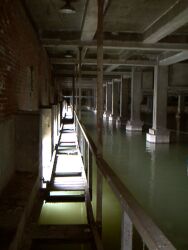 At the bottom of the hill, a portion of road or bridge is broken off above the entry to a dilapidated "room". Was that the sound of water up ahead? Oh yes. Coming inside, Ninj and I were completely stunned to find the remains of Court Street station -- the majority of which was a large chamber filled with water, broken pipes in the ceiling above creating incredibly gorgeous urban waterfalls. Two stone archways formed the back wall (in the same direction we'd come from) of the water-chamber, which was elevated about three feet from the ground and accessed by a short ladder and various walkways. On the south side of the chamber, low cement arches allowed the water to drop freely to a path returning it to the Genessee River, cascading across flat smooth rocks down a low waterfall. On the north side of this room were the remains of the staircase into the station, barely existing but still gorgeous for the arched structure underneath. The evidence of someone's bed lay up the stairs, so we didn't explore here. Going further inside, a strange little house/building appeared over to the right, its former purpose unclear.
At the bottom of the hill, a portion of road or bridge is broken off above the entry to a dilapidated "room". Was that the sound of water up ahead? Oh yes. Coming inside, Ninj and I were completely stunned to find the remains of Court Street station -- the majority of which was a large chamber filled with water, broken pipes in the ceiling above creating incredibly gorgeous urban waterfalls. Two stone archways formed the back wall (in the same direction we'd come from) of the water-chamber, which was elevated about three feet from the ground and accessed by a short ladder and various walkways. On the south side of the chamber, low cement arches allowed the water to drop freely to a path returning it to the Genessee River, cascading across flat smooth rocks down a low waterfall. On the north side of this room were the remains of the staircase into the station, barely existing but still gorgeous for the arched structure underneath. The evidence of someone's bed lay up the stairs, so we didn't explore here. Going further inside, a strange little house/building appeared over to the right, its former purpose unclear.
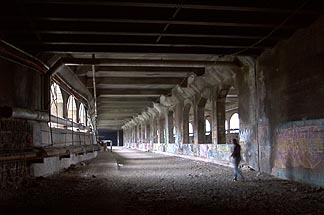 The path then curved to the left and within a few short steps we found ourselves along the scenic, heavily graffitied subway tunnel under the Broad Street Bridge. We took the south half of the tunnel along its length -- the whole portion of the journey had been exceedingly well-lit so far (in fact, part of Court Street station is still being lit by a few sodium lamps), and the bridge itself was the brightest, a cement tunnel with open archways all the way across the Genesse. Up ahead, though, was about the darkest thing I had ever seen. Twin pitch-black holes greeted us at the end of the span. Our pocket flashlights cowered in their spectre. We turned them on and entered the first fully underground tunnel.
The path then curved to the left and within a few short steps we found ourselves along the scenic, heavily graffitied subway tunnel under the Broad Street Bridge. We took the south half of the tunnel along its length -- the whole portion of the journey had been exceedingly well-lit so far (in fact, part of Court Street station is still being lit by a few sodium lamps), and the bridge itself was the brightest, a cement tunnel with open archways all the way across the Genesse. Up ahead, though, was about the darkest thing I had ever seen. Twin pitch-black holes greeted us at the end of the span. Our pocket flashlights cowered in their spectre. We turned them on and entered the first fully underground tunnel.
Dark, dark, and dark, this tunnel creeped me out. The further we got from the Broad Street bridge, the more I kept sticking my flashlight into corners to make sure no person or thing I didn't want to encounter was there. The ground was dirty and gravelly, and we found the remains of a track bed and began to walk along that. Large chunks of rock regularly appeared at our feet, so the going was careful. Portions of rail still remained. Pillars flanked us on both sides, but the tunnel was really very wide. Thinking back on what I know now, I think many portions of the tunnel had room for at least three tracks, two for passenger subways and one for freight traffic. No evidence of former platforms was at any time visible.
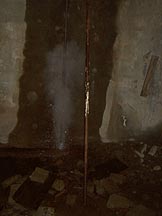 A bizarre ratchetty noise ("like the metal sound of a rollercoaster going uphill" according to Ninj, who likes rollercoasters more than I do) was off in the distance. We stopped and listened for awhile -- it was too regular to be human, but it was still creepy in all that darkness. Near the end of this segment of tunnel we found the culprit: an exceptionally loud, yet small, steam valve, shooting geysers of steam high into the air at regular intervals. Near the geyser, blocking the front of the track, was a portion of wall, with an open doorway. We went through the doorway to be greeted by a blast of hot, moist air... and more tunnel.
A bizarre ratchetty noise ("like the metal sound of a rollercoaster going uphill" according to Ninj, who likes rollercoasters more than I do) was off in the distance. We stopped and listened for awhile -- it was too regular to be human, but it was still creepy in all that darkness. Near the end of this segment of tunnel we found the culprit: an exceptionally loud, yet small, steam valve, shooting geysers of steam high into the air at regular intervals. Near the geyser, blocking the front of the track, was a portion of wall, with an open doorway. We went through the doorway to be greeted by a blast of hot, moist air... and more tunnel.
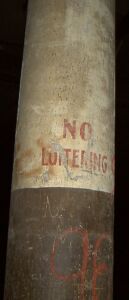 This second dark tunnel was even darker than the first, if that's even possible. With flashlights off it would be pitch black in all directions, and I seem to remember repeating "this is really scary" a few times as we kept going further and further into this superdark, remarkably sauna-like hole. The track bed here had become paved in the centre, and this was easy to walk along while looking around trying to figure out where we were changing from tunnel to station, if at all. On the south side were tracks punctuated by those large triangular wooden things they use, well, at the end of railroad track. I gather that this segment of track was for freight, as they ran alongside what we would soon discover were the old loading docks of the Gannet newspaper plant. This accounted for the stray bits of safety signage (that was definitely NOT circa 1957) we'd seen just nearby. The docks had a few dirty gloves and fuses lying around, but nothing of interest. (Really, there were no artifacts anywhere in the tunnels at all, save for the usual beer cans, destroyed cassette tapes, and what I am pretty sure was once a saucy red-and-silver lingerie ensemble.) At some point here the pillars changed from square to round, and we could read the stencilled words "NO LOITERING" on some of the poles. This was City Hall Station, or what was left of it, anyway.
This second dark tunnel was even darker than the first, if that's even possible. With flashlights off it would be pitch black in all directions, and I seem to remember repeating "this is really scary" a few times as we kept going further and further into this superdark, remarkably sauna-like hole. The track bed here had become paved in the centre, and this was easy to walk along while looking around trying to figure out where we were changing from tunnel to station, if at all. On the south side were tracks punctuated by those large triangular wooden things they use, well, at the end of railroad track. I gather that this segment of track was for freight, as they ran alongside what we would soon discover were the old loading docks of the Gannet newspaper plant. This accounted for the stray bits of safety signage (that was definitely NOT circa 1957) we'd seen just nearby. The docks had a few dirty gloves and fuses lying around, but nothing of interest. (Really, there were no artifacts anywhere in the tunnels at all, save for the usual beer cans, destroyed cassette tapes, and what I am pretty sure was once a saucy red-and-silver lingerie ensemble.) At some point here the pillars changed from square to round, and we could read the stencilled words "NO LOITERING" on some of the poles. This was City Hall Station, or what was left of it, anyway.
Now, while I mentioned already that this was the darkest and most uncomfortable of the tunnels, it was also the scariest, due to a terrifying and LOUD noise that we had been hearing grow louder all the way back from the entrance. This noise sounded like nothing less fearsome than a zombie-monster dragging its enormous coffin behind it, trailing metal chains along the ground. It was god-awful sounding, really. The only human thing I could even conceive of it being in real life was a batallion of angry homeless residents hauling heavy trash cans behind them in order to attack us, but that seemed rather unlikely, and, like the noise before, the pattern was far too regular for it to be human. That didn't keep me from being deeply spooked every time the sound cycled (which was every ten seconds or so). At times it seemed to be coming from ahead of us, at times it seemed to be right above us. But we kept going forward, eventually coming upon the root of the cacophany: yep, another humble steam valve. This would be an excellent site for field recordings...
At the end of this tunnel was another phantom dead-end. That is, approaching the ends of these tunnels we kept half-expecting them to be walled-off, as I'd understood some of the segments of the subway were. But as we got closer, there was yet another passageway into the next room -- and this one had light leaking in from above! And sand on the ground instead of rubble or pavement. And in the sand... tire tracks. I remembered reading on the net about a guy who had driven a jeep into one of the tunnels, and I wondered if this tunnel didn't go above-ground again soon. We approached a portion of tunnel where the room changed character again and decided this must be West Main station. More and more light came from the southeast, and we were very curious to find out where it ended up when we saw our first rat. Our little friend was black and chubby. More than the humans or danger or scary noises, this rat scared us both. We stood in place and discussed the rat for a little while, then cautiously kept going. A few minutes later we saw a second, much larger rat, and with little ado, decided they'd be much happier alone in their rat-world and turned back along the long path.
We suspect the tunnels do indeed emerge again not too far past where we gave up. This map from 1928 seems to indicate that the track heads above-ground again near Exchange Street, which would probably account for the tire tracks, and the proliferation of rats due to the proximity to humans and trash, and explain why it got so much pleasantly cooler the further away from Sauna Tunnel we went.
Anyway, we made our way back out (Ninj pointed out that these tunnels would be extra-unpleasant for a claustrophobe -- it's a long way out once you're way in, and there are no possible emergency exits) not too dirty and completely unscathed. The residents or visitors we'd seen at the entry earlier were nowhere to be seen, so we enjoyed the water room for a little while longer and headed out into the overcast, but suddenly very bright, Rochester afternoon.
(You can see more pictures of this trip at Viewing Hole Gallery.)
 Merchandise Building (September 2000): I was so impressed with Throckmorten's write-up of the Merchandise Building in Infiltration 7 that I decided to live there. The Merchandise Building was constructed in the 1920s, and functioned as a gigantic, 12-storey warehouse for Sears for most of its existence. My grandmother used to work there when she was little.
Merchandise Building (September 2000): I was so impressed with Throckmorten's write-up of the Merchandise Building in Infiltration 7 that I decided to live there. The Merchandise Building was constructed in the 1920s, and functioned as a gigantic, 12-storey warehouse for Sears for most of its existence. My grandmother used to work there when she was little.
In any case, the conversion of the building into condos was nowhere near completed when I moved in. In fact, things were still very primitive, and security was basically non-existent. During the year or so that I lived there, I often nursed my infiltrating urges at home. On a few occasions I found unlocked doors into other units in various stages of construction. I found hidden stairwells leading to large, disused rooms, and doors to the grocery store that was attached to the residential portion of the building. Liz and I explored the ever-under-construction indoor recreation centre on many occasions. I made my way into the basement. And, on one lovely occasion, Liz and I explored the building's largest top-level suite and the roof of the building, which offered a great view.
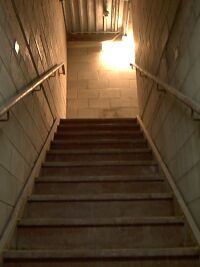 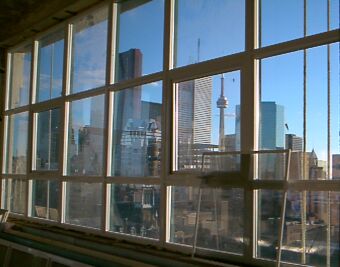
The Merchandise Building really was a lovely place; it's unfortunate that the company that made it into condos was so lacking in competence and aesthetic sensibility. Eventually I gave up and moved somewhere better.
 Church-Dundas Pit (early October 2000): Liz noticed that some fairly intense excavation was going on near my place at Church and Dundas (Toronto). After peering through the fence into the large, 10-foot-deep hole wistfully on several occasions, we eventually had enough, and thus at 4a.m. one morning we dressed up in dark clothes and decided to see exactly what was going on down there.
Church-Dundas Pit (early October 2000): Liz noticed that some fairly intense excavation was going on near my place at Church and Dundas (Toronto). After peering through the fence into the large, 10-foot-deep hole wistfully on several occasions, we eventually had enough, and thus at 4a.m. one morning we dressed up in dark clothes and decided to see exactly what was going on down there.
 Both Church and Dundas are fairly busy streets, even at 4a.m., so we had to loiter for a fair while before a chance came for us to get past the orange plastic fencing around the pit. Once on the other side, we swiftly descended into the pit and up the tunnel to the south, out of sight of anyone on the street. Not surprisingly, the tunnel was very small and unlit. I had expected the tunnel to have something to do with plumbing, but there were no pipes to be seen. The walls and ceiling had been reinforced with wooden boards, but the floor was just dirt. We were delighted to see a set of tracks had been put in place. Following these for a short distance, we came across a mining cart that occupied pretty much the entire width of the tunnel. Passing this and continuing on a short way, I came to the end of the line, where something that looked like a simple electrical panel was set into the dirt wall. It didn't look like it was hooked up to anything and I couldn't really figure out what purpose it was intended to serve.
Both Church and Dundas are fairly busy streets, even at 4a.m., so we had to loiter for a fair while before a chance came for us to get past the orange plastic fencing around the pit. Once on the other side, we swiftly descended into the pit and up the tunnel to the south, out of sight of anyone on the street. Not surprisingly, the tunnel was very small and unlit. I had expected the tunnel to have something to do with plumbing, but there were no pipes to be seen. The walls and ceiling had been reinforced with wooden boards, but the floor was just dirt. We were delighted to see a set of tracks had been put in place. Following these for a short distance, we came across a mining cart that occupied pretty much the entire width of the tunnel. Passing this and continuing on a short way, I came to the end of the line, where something that looked like a simple electrical panel was set into the dirt wall. It didn't look like it was hooked up to anything and I couldn't really figure out what purpose it was intended to serve.
Having seen everything, we left after less than 20 minutes. We fully intended to return regularly to check on the tunnel's progress and see if we could determine its purpose, but it was suddenly sealed up a few days later.
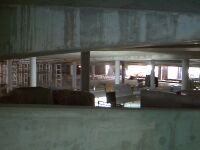 Parking Garage (October 2000): Liz and I slipped through some gates late one night to check out the new mega-parking-garage being carved out of the earth beneath Yonge and Dundas (Toronto). I know most people don't find parking garages very interesting, but I've loved them since I was little, and this one is going to be pretty fantastic. Depending on how you count the levels, there are either six or twelve vast levels of subterranean parking, as well as various ramps, public stairwells, emergency exits, ventilation shafts and mechanical rooms. And it smells awesome.
Parking Garage (October 2000): Liz and I slipped through some gates late one night to check out the new mega-parking-garage being carved out of the earth beneath Yonge and Dundas (Toronto). I know most people don't find parking garages very interesting, but I've loved them since I was little, and this one is going to be pretty fantastic. Depending on how you count the levels, there are either six or twelve vast levels of subterranean parking, as well as various ramps, public stairwells, emergency exits, ventilation shafts and mechanical rooms. And it smells awesome.
York University (November 2000): Tried to show Liz some steam tunnels at York University (Toronto), but found to our dismay that the old entrances have been fortified with solid steel doors ("steel ass door"s, in the words of one graffitist). Additionally, the public tunnels at York have acquired roughly 4,000,000 new security cameras. No fun.
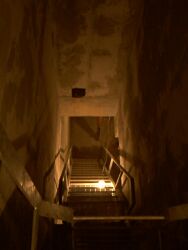  Sheppard Subway construction (November 2000): Liz and I decided to check on the progress of Toronto's new subway line and some of its stations-to-be. Starting out around the future Bessarion station late one night, we peeled back some fence and climbed down into a large pit. Looking around a little, we found a ladder leading down a storey to a hidden tunnel, leading to a hidden staircase down two storeys to some nice round tunnels.
Sheppard Subway construction (November 2000): Liz and I decided to check on the progress of Toronto's new subway line and some of its stations-to-be. Starting out around the future Bessarion station late one night, we peeled back some fence and climbed down into a large pit. Looking around a little, we found a ladder leading down a storey to a hidden tunnel, leading to a hidden staircase down two storeys to some nice round tunnels.
After taking some pictures and reclining on the tracks for a bit, we headed east along the line until we got to Leslie station, which seems to be the most developed of the various new stations. We spend something approaching an hour here poking into all the various nooks and crannies, crawling underneath the platform, surveying mechanical rooms, examining TTC blueprints and maps, and marvelling at the giant disconnected escalators which had been freshly imported from Germany. We have no idea how they got these monstrous machines down here. We then left the same way we came in. (Liz has a more photo-intensive account of this trip at Viewing Hole Gallery.)
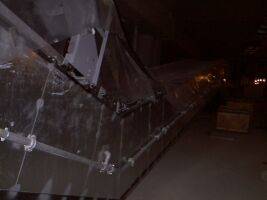 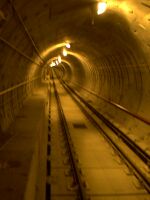
Back to 1999 | Location Index | Onward to 2001

 The full, paper version of Infiltration can be ordered for $2 cash (US or Cnd) from Infiltration, PO Box 13, Station E, Toronto, Ontario, M6H 4E1, Canada.
Please toss any comments, queries or contributions to Ninjalicious.
The full, paper version of Infiltration can be ordered for $2 cash (US or Cnd) from Infiltration, PO Box 13, Station E, Toronto, Ontario, M6H 4E1, Canada.
Please toss any comments, queries or contributions to Ninjalicious.
|








 Moving right along, we soon came to a section of the drain that was quite flooded with deep, cold, rapidly-flowing water. Mike told me that this section wasn't usually so flooded, and that he wanted to press on and see if the water level went down enough that we could continue to an interesting exit he knew about. I was feeling pretty sick for some reason. I didn't want to get soaked, but I also really didn't want to go back the (long) way we'd come in, so I accepted Mike's offer to scout ahead and see if we could continue. We agreed that he'd take my flashlight and a glowstick, and that he'd either come back if the route was impassable or give me a signal if I should follow him up the flooded drain.
Moving right along, we soon came to a section of the drain that was quite flooded with deep, cold, rapidly-flowing water. Mike told me that this section wasn't usually so flooded, and that he wanted to press on and see if the water level went down enough that we could continue to an interesting exit he knew about. I was feeling pretty sick for some reason. I didn't want to get soaked, but I also really didn't want to go back the (long) way we'd come in, so I accepted Mike's offer to scout ahead and see if we could continue. We agreed that he'd take my flashlight and a glowstick, and that he'd either come back if the route was impassable or give me a signal if I should follow him up the flooded drain. I say "side tunnel" but I'm being generous; in actuality, this thing was just a thin pipe, not more than two feet in diameter. A raccoon could walk through it easily enough, but it was clearly not meant to accomodate humans. In fact, if Mike hadn't tossed his backpack ahead of him and begun to wriggle up the pipe, I might have assumed it wasn't humanly possible. I thanked god I hadn't had a lot to eat that day and began to slither up afterwards, thoroughly battering my knees and elbows in the process.
I say "side tunnel" but I'm being generous; in actuality, this thing was just a thin pipe, not more than two feet in diameter. A raccoon could walk through it easily enough, but it was clearly not meant to accomodate humans. In fact, if Mike hadn't tossed his backpack ahead of him and begun to wriggle up the pipe, I might have assumed it wasn't humanly possible. I thanked god I hadn't had a lot to eat that day and began to slither up afterwards, thoroughly battering my knees and elbows in the process.







 Michigan Central Station (April 2000): While Liz and I were in the Detroit area for a few days, we decided to take a closer look at the building that seems to have inspired more urban exploration websites than any other -- the city's gigantic, long-abandoned train station.
Michigan Central Station (April 2000): While Liz and I were in the Detroit area for a few days, we decided to take a closer look at the building that seems to have inspired more urban exploration websites than any other -- the city's gigantic, long-abandoned train station.  After touring the main floor and looking at the basement a bit, Liz and I headed up. On the second floor, we spotted some sort of authority (either railroad security or a private security guard) peering intently at the building from nearby, so we quickly hid. We knew we'd have to cross his line of vision in order to continue our ascent, so we just waited for him to go away. Fifteen minutes later, however, we were bored, so we just sort of shrugged and figured he could try and come and get us if he wanted to. We kept going.
After touring the main floor and looking at the basement a bit, Liz and I headed up. On the second floor, we spotted some sort of authority (either railroad security or a private security guard) peering intently at the building from nearby, so we quickly hid. We knew we'd have to cross his line of vision in order to continue our ascent, so we just waited for him to go away. Fifteen minutes later, however, we were bored, so we just sort of shrugged and figured he could try and come and get us if he wanted to. We kept going. Toronto Churches (July 2000): Ah,
Toronto Churches (July 2000): Ah,  Eaton Centre Roof (August 2000): Usually I prefer to get to the tops of buildings from the inside, but when a stranger named Dan invited me to join him in climbing atop the galleria roof of Toronto’s Eaton Centre, I couldn’t really say no. Crossing the large glass roof, we’d be immensely visible to anyone in the mall below us, and nothing but a thin layer of glass would be keeping us from falling several hundred feet. Yet scaling the famous rooftop and staring down on 12 levels of offices and retail stores sounded like an intensely memorable experience. Besides, Dan assured me that he’d done it once before and it had gone off smoothly.
Eaton Centre Roof (August 2000): Usually I prefer to get to the tops of buildings from the inside, but when a stranger named Dan invited me to join him in climbing atop the galleria roof of Toronto’s Eaton Centre, I couldn’t really say no. Crossing the large glass roof, we’d be immensely visible to anyone in the mall below us, and nothing but a thin layer of glass would be keeping us from falling several hundred feet. Yet scaling the famous rooftop and staring down on 12 levels of offices and retail stores sounded like an intensely memorable experience. Besides, Dan assured me that he’d done it once before and it had gone off smoothly. Arriving late one night after the mall had closed, Dan and I made our way up to the top of the building without much trouble. A steel casing for wiring was in place to help most of the way to the top of the arching glass roof, which was good, because we didn’t have any climbing gear aside from some rope we’d found on our way up. Dan went first, scrambling up the ladder quickly and waiting for me at the crest of the roof. I didn’t really like the idea of forcing the roof to support both of us at once, but I didn’t want to yell at Dan to get out of the way, so up I went. The two of us peered down at the empty but well-lit mall in all its majesty, noting happily that the two security guards right below us didn’t seem to be interested in looking up. We then hastily slid down the opposite side of the roof and dismounted, and I let out a huge sigh of relief. This escapade had felt incredibly dangerous to me, especially since I hardly knew Dan, and I hadn’t been quite sure if he was brave or just insane.
Arriving late one night after the mall had closed, Dan and I made our way up to the top of the building without much trouble. A steel casing for wiring was in place to help most of the way to the top of the arching glass roof, which was good, because we didn’t have any climbing gear aside from some rope we’d found on our way up. Dan went first, scrambling up the ladder quickly and waiting for me at the crest of the roof. I didn’t really like the idea of forcing the roof to support both of us at once, but I didn’t want to yell at Dan to get out of the way, so up I went. The two of us peered down at the empty but well-lit mall in all its majesty, noting happily that the two security guards right below us didn’t seem to be interested in looking up. We then hastily slid down the opposite side of the roof and dismounted, and I let out a huge sigh of relief. This escapade had felt incredibly dangerous to me, especially since I hardly knew Dan, and I hadn’t been quite sure if he was brave or just insane.



 The path then curved to the left and within a few short steps we found ourselves along the scenic, heavily graffitied subway tunnel under the Broad Street Bridge. We took the south half of the tunnel along its length -- the whole portion of the journey had been exceedingly well-lit so far (in fact, part of Court Street station is still being lit by a few sodium lamps), and the bridge itself was the brightest, a cement tunnel with open archways all the way across the Genesse. Up ahead, though, was about the darkest thing I had ever seen. Twin pitch-black holes greeted us at the end of the span. Our pocket flashlights cowered in their spectre. We turned them on and entered the first fully underground tunnel.
The path then curved to the left and within a few short steps we found ourselves along the scenic, heavily graffitied subway tunnel under the Broad Street Bridge. We took the south half of the tunnel along its length -- the whole portion of the journey had been exceedingly well-lit so far (in fact, part of Court Street station is still being lit by a few sodium lamps), and the bridge itself was the brightest, a cement tunnel with open archways all the way across the Genesse. Up ahead, though, was about the darkest thing I had ever seen. Twin pitch-black holes greeted us at the end of the span. Our pocket flashlights cowered in their spectre. We turned them on and entered the first fully underground tunnel. A bizarre ratchetty noise ("like the metal sound of a rollercoaster going uphill" according to Ninj, who likes rollercoasters more than I do) was off in the distance. We stopped and listened for awhile -- it was too regular to be human, but it was still creepy in all that darkness. Near the end of this segment of tunnel we found the culprit: an exceptionally loud, yet small, steam valve, shooting geysers of steam high into the air at regular intervals. Near the geyser, blocking the front of the track, was a portion of wall, with an open doorway. We went through the doorway to be greeted by a blast of hot, moist air... and more tunnel.
A bizarre ratchetty noise ("like the metal sound of a rollercoaster going uphill" according to Ninj, who likes rollercoasters more than I do) was off in the distance. We stopped and listened for awhile -- it was too regular to be human, but it was still creepy in all that darkness. Near the end of this segment of tunnel we found the culprit: an exceptionally loud, yet small, steam valve, shooting geysers of steam high into the air at regular intervals. Near the geyser, blocking the front of the track, was a portion of wall, with an open doorway. We went through the doorway to be greeted by a blast of hot, moist air... and more tunnel. This second dark tunnel was even darker than the first, if that's even possible. With flashlights off it would be pitch black in all directions, and I seem to remember repeating "this is really scary" a few times as we kept going further and further into this superdark, remarkably sauna-like hole. The track bed here had become paved in the centre, and this was easy to walk along while looking around trying to figure out where we were changing from tunnel to station, if at all. On the south side were tracks punctuated by those large triangular wooden things they use, well, at the end of railroad track. I gather that this segment of track was for freight, as they ran alongside what we would soon discover were the old loading docks of the Gannet newspaper plant. This accounted for the stray bits of safety signage (that was definitely NOT circa 1957) we'd seen just nearby. The docks had a few dirty gloves and fuses lying around, but nothing of interest. (Really, there were no artifacts anywhere in the tunnels at all, save for the usual beer cans, destroyed cassette tapes, and what I am pretty sure was once a saucy red-and-silver lingerie ensemble.) At some point here the pillars changed from square to round, and we could read the stencilled words "NO LOITERING" on some of the poles. This was City Hall Station, or what was left of it, anyway.
This second dark tunnel was even darker than the first, if that's even possible. With flashlights off it would be pitch black in all directions, and I seem to remember repeating "this is really scary" a few times as we kept going further and further into this superdark, remarkably sauna-like hole. The track bed here had become paved in the centre, and this was easy to walk along while looking around trying to figure out where we were changing from tunnel to station, if at all. On the south side were tracks punctuated by those large triangular wooden things they use, well, at the end of railroad track. I gather that this segment of track was for freight, as they ran alongside what we would soon discover were the old loading docks of the Gannet newspaper plant. This accounted for the stray bits of safety signage (that was definitely NOT circa 1957) we'd seen just nearby. The docks had a few dirty gloves and fuses lying around, but nothing of interest. (Really, there were no artifacts anywhere in the tunnels at all, save for the usual beer cans, destroyed cassette tapes, and what I am pretty sure was once a saucy red-and-silver lingerie ensemble.) At some point here the pillars changed from square to round, and we could read the stencilled words "NO LOITERING" on some of the poles. This was City Hall Station, or what was left of it, anyway. Merchandise Building (September 2000): I was so impressed with Throckmorten's write-up of the Merchandise Building in
Merchandise Building (September 2000): I was so impressed with Throckmorten's write-up of the Merchandise Building in  Church-Dundas Pit (early October 2000): Liz noticed that some fairly intense excavation was going on near my place at Church and Dundas (Toronto). After peering through the fence into the large, 10-foot-deep hole wistfully on several occasions, we eventually had enough, and thus at 4a.m. one morning we dressed up in dark clothes and decided to see exactly what was going on down there.
Church-Dundas Pit (early October 2000): Liz noticed that some fairly intense excavation was going on near my place at Church and Dundas (Toronto). After peering through the fence into the large, 10-foot-deep hole wistfully on several occasions, we eventually had enough, and thus at 4a.m. one morning we dressed up in dark clothes and decided to see exactly what was going on down there. Both Church and Dundas are fairly busy streets, even at 4a.m., so we had to loiter for a fair while before a chance came for us to get past the orange plastic fencing around the pit. Once on the other side, we swiftly descended into the pit and up the tunnel to the south, out of sight of anyone on the street. Not surprisingly, the tunnel was very small and unlit. I had expected the tunnel to have something to do with plumbing, but there were no pipes to be seen. The walls and ceiling had been reinforced with wooden boards, but the floor was just dirt. We were delighted to see a set of tracks had been put in place. Following these for a short distance, we came across a mining cart that occupied pretty much the entire width of the tunnel. Passing this and continuing on a short way, I came to the end of the line, where something that looked like a simple electrical panel was set into the dirt wall. It didn't look like it was hooked up to anything and I couldn't really figure out what purpose it was intended to serve.
Both Church and Dundas are fairly busy streets, even at 4a.m., so we had to loiter for a fair while before a chance came for us to get past the orange plastic fencing around the pit. Once on the other side, we swiftly descended into the pit and up the tunnel to the south, out of sight of anyone on the street. Not surprisingly, the tunnel was very small and unlit. I had expected the tunnel to have something to do with plumbing, but there were no pipes to be seen. The walls and ceiling had been reinforced with wooden boards, but the floor was just dirt. We were delighted to see a set of tracks had been put in place. Following these for a short distance, we came across a mining cart that occupied pretty much the entire width of the tunnel. Passing this and continuing on a short way, I came to the end of the line, where something that looked like a simple electrical panel was set into the dirt wall. It didn't look like it was hooked up to anything and I couldn't really figure out what purpose it was intended to serve.  Parking Garage (October 2000): Liz and I slipped through some gates late one night to check out the new mega-parking-garage being carved out of the earth beneath Yonge and Dundas (Toronto). I know most people don't find parking garages very interesting, but I've loved them since I was little, and this one is going to be pretty fantastic. Depending on how you count the levels, there are either six or twelve vast levels of subterranean parking, as well as various ramps, public stairwells, emergency exits, ventilation shafts and mechanical rooms. And it smells awesome.
Parking Garage (October 2000): Liz and I slipped through some gates late one night to check out the new mega-parking-garage being carved out of the earth beneath Yonge and Dundas (Toronto). I know most people don't find parking garages very interesting, but I've loved them since I was little, and this one is going to be pretty fantastic. Depending on how you count the levels, there are either six or twelve vast levels of subterranean parking, as well as various ramps, public stairwells, emergency exits, ventilation shafts and mechanical rooms. And it smells awesome.